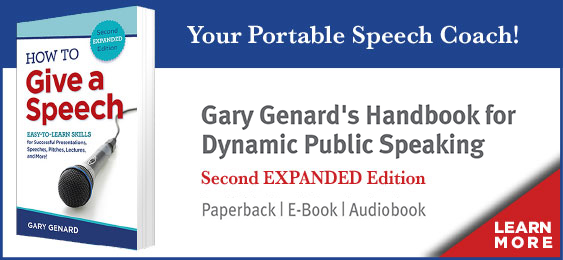
Wondering how to organize a presentation to persuade audiences? Use this approach to know how to start a speech, how to end a speech powerfully, and create maximum engagement in between!
When it comes to organizing a presentation, here's an important truth to bear in mind: your greatest success doesn't depend upon your content. It's much more about you and your relationship with the audience.
And honestly, can you think of better news concerning public speaking?
You're not a robot! Your task in organizing a speech, then, isn't to create conditions where you regurgitate information via slides or a manuscript. You're there to create influence—not only through what you say but how you say it.
Like an actor, you work the crowd in the here and now, in the form of community known as public performance. The journey you and the audience take together depends not only on your expertise and passion (and you'd better have both), but your ability to connect with and move people. That's getting on the right wavelength when it comes to how to persuade an audience.
How do you achieve this level of effectiveness, so you stand out for all the right reasons? Discover how to perform at your best! Download my free e-book, "12 Easy Ways to Achieve Presence and Charisma."
You probably won't be surprised to know that there are rules to this game. They concern some tried-and-true methods of engaging listeners, from learning how to start a presentation to concluding with power and purpose. Together, they constitute the best way to plan a speech.
This approach is a central part of The Genard Method of performance-based public speaking training, the system I created and teach. I explain it below. This isn't Public Speaking 101, however. To be successful, you don't need to follow a rigid plan of how to organize a speech. You do need to study how to put a presentation together in a way that makes you impactful and memorable. That's what I talk about below.
The 5 Essential Parts of a Speech or Presentation
I'll be discussing five parts of your speech that are essential to your success. Paradoxically, I won't spend much time on the largest element, because that's the one where you're already strongest. The five parts are: Greeting, Grabber, Preview, Body, and Clincher.
In terms of getting your information across, the chances are you'll be in good shape concerning the body. That's where the meat of your content, with all of your main points, comes. Provided that you know your topic you should do well here. In addition, since it comes at least a few minutes into your talk, by this time you'll be over what I call the awful first two minutes when you're most subject to speech anxiety.
The first portion of your speech worth discussing is one you may not think much about. It's not the speech introduction, but your greeting. Most of us are intent on delivering content—and so we may gloss over the moment when we first speak to an audience. But this is a critical time: the moment when you establish a relationship with these people; show them you're likable and confident; and demonstrate that you're going to be interesting. So start making those things happen! Take your time when you start, and make it feel like you're having a conversation with everyone. Here's more on how to give your audience a greeting they'll remember.
How to Grab Listeners' Attention and Clinch the Deal
Congratulations! Through your greeting, you've successfully begun a relationship with listeners. Now you're facing the most critical moment in your presentation, which I also think can be the most fun for you. That's because both you and your listeners are primed for what comes next.
It all has to do with the concept of primacy—and the speaking tool you use to exploit it is your grabber. Primacy states that audiences retain best what they experience first. And why wouldn't they? Everyone is focused at the start of a talk: the curtain is about to go up, and we don't know what to expect. For you as speaker, the equation is simple: give them something interesting and exciting, and they will pay attention and be "primed" to be influenced.
This is where your grabber comes in. The grabber or "hook" has some important functions. It must a) engage the audience, b) pique their interest (if it surprises them, so much the better), c) present your topic in an interesting light, and most important d) speak to them where they live, tapping into who they are and how they think. Here are 12 foolproof ways to start a speech.
Following the body of your talk (which you know so well, remember?), you'll be faced with a similar situation in your conclusion. That is, you need to end vividly and memorably, so your essential argument continues to resonate long after you've finished speaking. Similar to primacy, you're now concerned with the concept of recency. This states that audiences strongly retain what they experience last, or more "recently." Here's some great news: the same rhetorical tools that work well as grabbers make excellent clinchers.
The Preview: The Journey You're Taking Together
Finally (though this part of your talk comes before the body and the clincher), the preview. This is the moment when you tell the audience about the journey you'll be taking together, and how you'll get there. Another metaphor you may prefer: a blueprint of the speech which shows how it all fits together.
The preview is the speech element which a majority of speakers leave out. Again, they're concerned with delivering content, and forget to share why it should matter to the audience. Every listener is always in a "what's-in-it-for-me" mode, and you help your case immeasurably when you actually tell them.
Basically, it can be as as simple as: "These are the specific points I'll be discussing in this talk. The reason I want to share this with you today is . . . " Isn't it more effective to tell people how what you'll be saying will enrich them or make their life easier, than to just hop onto a slide that reads "Agenda" with five barren bullet points? It's such an obvious need that I think speakers don't even see it: a forest for the trees thing. But once your audience hears why this talk matters to them and accepts it, believe me, they'll be engaged with what you're saying.
How to Structure Your Actual Speech
So, in the interests of clarity, here's the order the 5 essential parts of the speech will appear in your actual talk:
-
Greeting
-
Introduction with Grabber
-
Preview
-
Body
-
Conclusion with Clincher
If you work this way in planning and delivering a speech, you'll be virtually predetermining your success. (Assuming, of course, that your content is solid and necessary for this audience to hear). Rather than making you or your content the sun, you'll be making the audience the center of your solar system. But it's you who will shine.
You should follow me on Twitter here.



